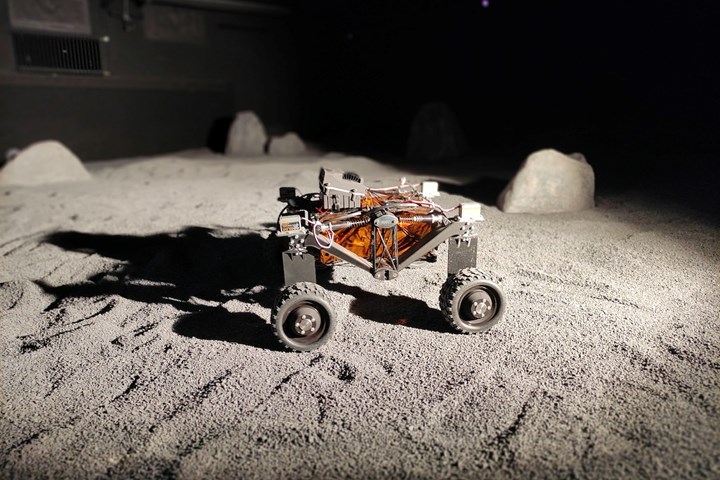3D printing on the moon: Anisoprint chosen for Start-up Space Program
During SSP, Anisoprint will work to develop composite fiber 3D printing in close-to-zero gravity conditions.
Share
A lunar rover with an anisoprinted composite suspension using carbon fiber-reinforced polyamide (PA). Photo Credit: Anisoprint
Anisoprint (Esch-sur-Alzette, Luxembourg), a composite fiber 3D printing technology pioneer, was selected to participate in the Startup Support Program (SSP) managed by European Space Resources Innovation Centre (ESRIC) in partnership with Technoport, the Luxembourg Space Agency (LSA), the Luxembourg Institute of Science and Technology (LIST) and the European Space Agency (ESA). SSP’s goal is to develop the space resources ecosystem by providing a platform for entrepreneurs with business ideas targeting terrestrial and space applications.
ESRIC has launched SSP worldwide for technology and commercial projects in the area of space resource utilization. Following the initial call for applications in 2021, a total of 33 start-ups applied from 17 countries. Only five met the tough criteria for the program. The business incubator selected only five teams for developing innovative and reliable technologies in terrestrial and space industry markets.
Anisoprint’s patented continuous fiber co-extrusion technology enables lightweight yet strong 3D printed fiber-reinforced composite sturctures. Photo Credit: Anisoprint
Enabling 3D printing in outer space
Anisoprint applied to participate in the ESRIC incubator to adjust composite fiber 3D printing for close-to-zero gravity conditions. During the SSP, the team will work on the development of equipment allowing 3D printing of tools, components, repair parts and structural elements made of composite materials in conditions of weightlessness and low gravity. The project will support the development, extraction and use of space resources.
“Space is a huge opportunity and an exciting challenge, and ultimately space exploration is the frontier of engineering progress,” says Fedor Antonov, Anisoprint CEO. “In-space manufacturing, in-orbit manufacturing were always my biggest endeavors. The Luxembourg government has designated spacetech as one of its top development priorities, and we are thrilled to have a chance to contribute to that under the ESRIC initiative.”
“Humanity will turn to the Moon for a sustainable and permanent presence,” notes Dmitrii Prokopiuk, Anisoprint head of space development. “To explore and find new resources, earth technologies need to be adjusted for use in space. Anisoprint creates new space technologies in 3D printing and our team is ready to contribute to this great project and to be a participant of the ESRIC initiative.“
Anisoprint’s diverse R&D team has significant expertise and many years of experience in composite materials. It includes people from 14 countries, who share a common mission: Enabling lightweight composite structures with Anisoprinting, a zero-waste manufacturing technology. The team is now expanding its activities to the space exploration sector.
“We are really looking forward to starting work with the Anisoprint team: they have invented a technology that is already successful on earth, we are eager to see it adjusted to space conditions,” says Lari Cujko, SSP lead.
Related Content
-
Optimizing a thermoplastic composite helicopter door hinge
9T Labs used Additive Fusion Technology to iterate CFRTP designs, fully exploit continuous fiber printing and outperform stainless steel and black metal designs in failure load and weight.
-
A new era for ceramic matrix composites
CMC is expanding, with new fiber production in Europe, faster processes and higher temperature materials enabling applications for industry, hypersonics and New Space.
-
Hybrid process marries continuous, discontinuous composites design
9T Labs and Purdue applied Additive Fusion Technology to engineer a performance- and cost-competitive aircraft bin pin bracket made from compression-molded continuous and discontinuous CFRTP.


















